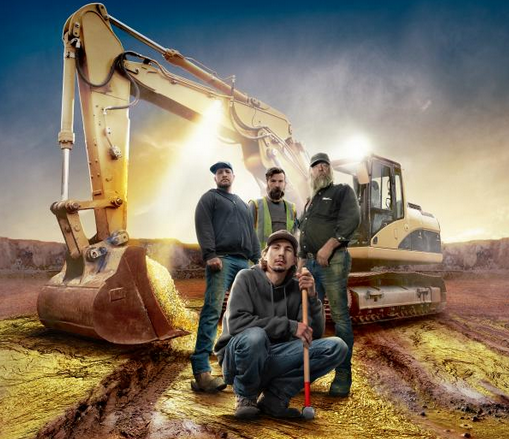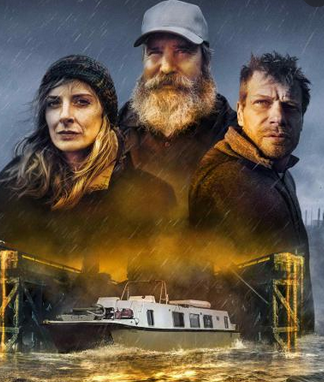Millions of viewers admit that their guilty pleasure is watching the TV show "Gold Rush" on the Discovery Channel. Every Friday night  for over a decade now, viewers have been enlightened and entertained by Gold Rush, Bering Sea Gold, White Water, and a couple of newer shows— Dave Turin's Lost Mine and Freddy Dodge's Mine Rescue. Although they’re off the air now, Under the Ice and Jungle Gold also captured attention a few years back. Aussie Gold Hunters is also interesting, and takes place in Western Australia.
for over a decade now, viewers have been enlightened and entertained by Gold Rush, Bering Sea Gold, White Water, and a couple of newer shows— Dave Turin's Lost Mine and Freddy Dodge's Mine Rescue. Although they’re off the air now, Under the Ice and Jungle Gold also captured attention a few years back. Aussie Gold Hunters is also interesting, and takes place in Western Australia.
Thanks to these reality TV shows, you’ll get to know more about Parker Schnabel, Rick Ness, Tony Beets, Dakota Fred, Emily Riedel, and Shawn Pomrenke than your own next door neighbors! And the scenery just can’t be beat either. Whether it’s the wide open spaces in Montana, Colorado and Arizona, or the snow-covered mountains of Alaska and the Yukon, the mining locations are nothing short of spectacular. Who wouldn’t want those views from their workplace every day?!
Reality television can be a compelling and very influential form of entertainment. It shows real people, real experiences (with some “Hollywood” thrown in) and viewers somehow relate to them, especially to the “stars” you either love or love to hate. The challenges of inter-miner-relationships that unfold in front of the viewing public can remind you of your own family dynamics, too. That being said, can you actually LEARN anything VALUABLE about gold mining by tuning in?
The answer is YES — especially when things go wrong. Seeing how a “gold guru” solves problems can teach all of us a thing or two about dealing with equipment failures, bad weather, uncooperative government agencies, and team dynamics. Although you may never run 300 yards of material an hour at your own mine site, if a belt tears, you can get a basic understanding of how to fix it thanks to the various repairs you see being performed by the crews on TV. Muddy water running over your sluice? Watch how the experts evaluate their pump and settling pond to get clear water flowing again. Finding gold in your tailings? Maybe the water flow is too fast or the riffles aren’t deep enough and gold is being washed out. When you see a miner stuck in the middle of nowhere without a replacement part, you just might remember to take along extras on your next trip. You’ve probably struggled with the pitch on your highbanker, and had to rely on duct tape a time or two. The celebrity miners face the same challenges, only on a much larger scale. And no matter who you are, some days you just don’t find gold, or perhaps not enough to pay for your fuel and other expenses.
Perhaps the most important lesson to take away from these TV shows is about pivoting. If the ground or stream you’re working doesn’t produce, despite the time and trouble you’ve already invested, re-think your strategy. Another valuable nugget you can take away from reality TV gold shows is preparation.

Do your research first. Successful miners don't just go out and find a random chunk of land and start digging. They review geological maps, talk to experts and test soil samples first. Before they start they already have a pretty good idea that they will find gold where they dig. They just don’t know how much they’ll find and how much effort and time it will require to get it out of the ground. The Bureau of Land Management’s new Mineral Land Records System (MLRS) is a geospatially enabled online land information system that allows miners to more readily research land status, discover mining claim activity, file new claims, pay fees, and more. And don’t forget good old-fashioned library research, too.
Plan for repairs. The heavy equipment used for gold mining includes bull dozers, dump trucks, and wash plants. The miners have teams of people that have the expertise to run and repair the equipment. Much of the drama on the Gold Rush shows occurs when their equipment breaks down. Even if all you are using is a shovel, stream sluice, and gold pan, you can’t find gold if your equipment is not up to snuff. Take extra sluice box matting and a few sizes of classifiers and pans on your next trip. If you just bought a Gold Cube or Desert Fox spiral panning machine, for example, set it up and learn to use it at home first. Become familiar with how a metal detector works before you try and use it in the field.
Be productive. Gold miners generally have a short season in which to find gold. They start when the ground thaws or the ice melts, and their season ends with the first winter snow. Consequently, they must make every minute count. Your operation might not be 24 hours per day, 7 days per week like on TV, but if you get the research done during winter down-time, you can hit the ground running in the spring and summer. If you test your equipment before you use it for the first time, you won’t be slowed down by surprise repairs quite as often.
Gold mining is a challenge, but as long as you’re reasonable with your expenditures and your expectations, it’s a heck of a lot of fun in the great outdoors. And it also gets you off the couch… just remember to record those reality shows so you can watch them at a later date when you’re not out in the gold fields "making it happening" as Gold Rush’s Tony Beets likes to say! Good luck!
A brief description of the Discovery channel’s most popular gold shows:
Gold Rush. The series follows the placer gold mining efforts of various family-run mining companies, mostly in the Klondike region of Dawson City, Yukon, Canada. Parker Schnabel, Rick Ness, and Tony Beets are the celebrity miners we’ve watch for 11 seasons.
White Water. Back where their gold-mining adventures began, `Gold Rush' alumni Dakota Fred and son Justin persevere in the face of long odds, risking their lives for a fortune they may never realize. Assisted by a team of intrepid divers, mountaineers and bush mechanics, the Dakota Boys explore the white water rapids of McKinley Creek in Alaska, diving deep in raging torrents with a suction dredge. Not only could one wrong move prove deadly, but the guys also face wild animals, extreme temperatures and hypothermia.
Bering Sea Gold. The gold rush in Alaska isn't confined to the state's precious ground. It's taking place on the sea ... or more accurately, on the bottom of the frigid Bering Sea. This series follows several gold dredges of all shapes and sizes, and their eccentric and driven crews who risk their lives to find as much gold as possible before winter sets in and it's too dangerous to dive.
Dave Turin's Lost Mine. Dave Turin spent years working alongside Todd Hoffman, earning the nickname `Dozer Dave' because of the many hours he spent bulldozing for gold. In this show, Dave is his own boss, and he's on a mission to find an abandoned mine to resurrect in the hope that old-timers left gold behind. He explores the history of each mine, a search that culminates in Dave picking the one that he can turn into newfound riches.
Freddy Dodge's Mine Rescue. A gold mining veteran with more than 40 years of mining under his belt, Freddy Dodge has earned the name “Gold Guru.” In each episode, Freddy “rescues” various small-time mining operations. He reveals hard-earned practical knowledge about where to look for gold as well as perfecting the miners’ equipment and techniques. He is joined on the show by expert mechanic and former Gold Rush miner Juan Ibarra.






 for over a decade now, viewers have been enlightened and entertained by Gold Rush, Bering Sea Gold, White Water, and a couple of newer shows— Dave Turin's Lost Mine and Freddy Dodge's Mine Rescue. Although they’re off the air now, Under the Ice and Jungle Gold also captured attention a few years back. Aussie Gold Hunters is also interesting, and takes place in Western Australia.
for over a decade now, viewers have been enlightened and entertained by Gold Rush, Bering Sea Gold, White Water, and a couple of newer shows— Dave Turin's Lost Mine and Freddy Dodge's Mine Rescue. Although they’re off the air now, Under the Ice and Jungle Gold also captured attention a few years back. Aussie Gold Hunters is also interesting, and takes place in Western Australia. 